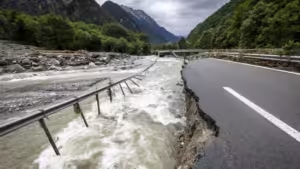Heavy rains caused widespread damage including triggering a landslide that buried part of a village in the southeast part of Switzerland. Switzerland is on high alert after heavy rains.
The famous tourist town of Zermatt was temporarily cut off from the rest of the country due to the rains, but rail services have since resumed. Additionally, three people are missing after a landslide in the Swiss Alps caused by heavy rainfall. The situation remains critical, and authorities are closely monitoring the weather conditions

On Saturday, emergency services searched for three missing people in southern Switzerland using helicopters, drones, and rescue dogs following severe downpours that created floods and landslides.
Authorities in Switzerland say rescuers have found the body of one of three people who had gone missing on Saturday after massive thunderstorms and rainfall in the southeast of the county caused a rockslide. Switzerland faces severe flooding: Rail services to Zermatt disrupted, Misox Valley buried in landslide rubble.

The Swiss Federal Office of Meteorology stated on its website that flood risks remain high. According to the public broadcaster SRF, more landslides are anticipated since heavily saturated earth cannot absorb additional rain.
Local media footage and images revealed overflowing rivers, a fallen road, and wreckage covering parts of the Misox valley in the canton of Graubuenden. The rains briefly stopped access to the popular tourist town of Zermatt, near the Matterhorn, shutting it off from the rest of the country. Rail service resumed Saturday evening, according to the Matterhorn-Gotthard Bahn.
In a post on X, President Viola Amherd described the damage as “shocking.”
Swiss Army soldiers were deployed to locate missing people and evacuate others.
Switzerland experiences heavy rains due to a combination of factors:

- Orographic Lifting: The unique geography of the Alps plays a significant role. When moist air is forced to rise over the mountains, it cools and condenses, leading to heavy precipitation.
- Presence of Lakes: Switzerland has numerous lakes, which contribute to local weather patterns. Lakes can enhance evaporation and moisture content in the air, leading to more rain.
- Climate Change Effects: Climate change has intensified extreme weather events globally. In Switzerland, this means more intense thunderstorms and heavy rainfall.
- Summer Thunderstorms: During summer, warm temperatures create favorable conditions for thunderstorms. Afternoons often see thunderstorms erupting across the country.
Switzerland employs several strategies to manage heavy rainfall:

- Flood Control Structures: The country has invested in flood control infrastructure, including dams, levees, and retention basins. These structures help regulate water flow during heavy rain events.
- Urban Drainage Systems: Swiss cities have well-designed drainage systems to prevent flooding. These include stormwater drains, underground tunnels, and reservoirs.
- Land Use Planning: Zoning regulations and land use planning consider flood-prone areas. Construction is restricted in floodplains, reducing vulnerability.
- Forest Management: Forests play a crucial role in regulating water flow. Switzerland maintains its forests to prevent soil erosion and landslides.
- Early Warning Systems: The Swiss government operates efficient early warning systems to alert residents about potential floods. These systems rely on meteorological data and river monitoring.
- Public Awareness and Preparedness: Education campaigns inform citizens about flood risks and safety measures. Emergency drills and evacuation plans are in place.
Long-term projections for Swiss flood risks are crucial as climate change continues to impact the country.









